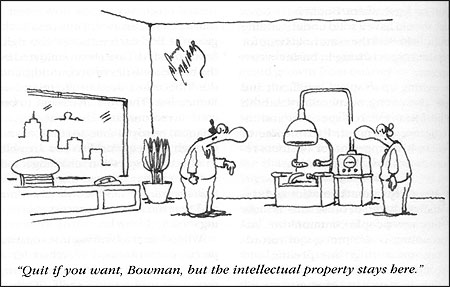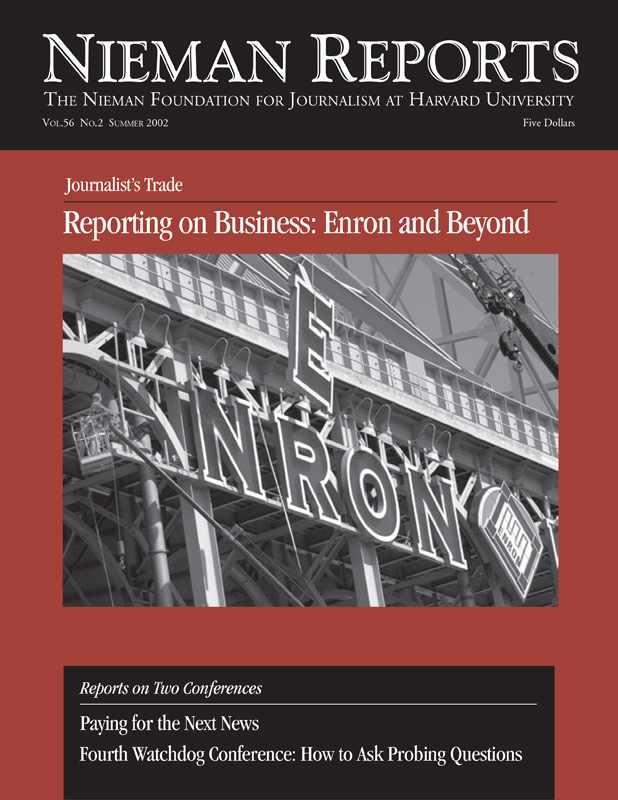
Cartoon by Scott Arthur Masear. Previously printed in the May 2002 Harvard Business Review.
The most important facts about business and economics coverage—and probably the most easily overlooked—are that there is a lot more of it now than there used to be and, almost certainly, it is better than it used to be. When I arrived at The Washington Post in early 1969, 18 months out of college, I was hired as a city reporter and asked, on showing up for work a couple of weeks later, to become a reporter in the business section. Unwilling to tell Ben Bradlee to shove it, I said yes and joined a staff of (as I recall) seven. There was the editor, Hobart Rowen, who covered some major breaking stories and also wrote a twice-weekly column; the local business editor, S. Oliver Goodman; the real estate editor, who put out a weekly section; two reporters, including me; a copy editor, and a copy boy.
Even that represented a huge expansion. When Bradlee moved from Newsweek in 1965, later bringing Ro-wen with him, the business section was Goodman, period. “Ollie wrote his [local business] column everyday, consisting of almost exclusively rewritten handouts, [and] then, as the market closed, went downstairs to lay in the agate [the agate type for the stock tables—this was before computerized listings],” recalls Bradlee. The Post’s national staff did have one reporter, Frank Porter, who covered economic stories, including the budget and the Federal Reserve. Porter remained after Rowen arrived.
My beat included the Civil Aeronautics Board (which regulated the airline industry—it has since been eliminated), the Interstate Commerce Commission (which regulated railroads and trucks), and the Federal Communications Commission, as well as occasional national stories (for example, the monthly Consumer Price Index) and local stories. The other reporter had the Securities and Exchange Commission, the Federal Trade Commission, and the Federal Power Commission, plus the odd national and local stories. As far as I know, these agencies weren’t covered on a full-time basis before Rowen.
As for the news “hole,” my memory and Bradlee’s coincide: no more than 10 to 12 columns a day on a then-eight column page. Converted to today’s six-column page, that would be at most a page and a half. The business page was tucked behind the sports section. These parts of the paper were for men. And the front of the business section was not clean. It had advertising.
Let’s fast forward. Jill Dutt, who now runs the Post’s business section, has a news hole of about four pages a day (24 columns on a six-column format). On Sunday, it becomes six and one-third pages (38 columns). Her staff is 85, including 52 reporters and columnists (plus one contract columnist), 14 assignment editors (including Dutt), 13 copy editors and graphic designers, four news aides (successors to copy boys), one researcher, and one administrative aide. The section’s front page is cleared of ads and is freestanding.
On quality, I do not think that the best reporters today are any better than the best reporters then. Rowen and Porter were first rate, as were Edwin L. Dale and Eileen Shanahan in The New York Times Washington bureau and Lee Cohn and Stephen Aug of the late Washington Star. But I think overall quality has improved for two reasons.
The first is sheer numbers. It’s not just more stories and more variety. Greater numbers also mean more competition to dig for stories and more competition to improve writing. There are more chances for people to share new ideas, information and perspectives—and to learn from each other’s strengths and, in theory, their mistakes. More does not always mean better. But in this case, I think it does, even though there is probably more frustration today with “getting in the paper.” Thirty years ago, that was not a problem.
The second source of improvement is something I can’t prove but think is true: On average, reporters are more qualified. When Bradlee asked me to join the business staff, he didn’t know that I had any real interest in business and economics. Frankly, neither did I. My main ambition was to be a newspaper reporter. In college, I spent most of my time working on the paper and hadn’t majored in economics, though I’d taken a few courses. The situation today seems different, as I discovered a few months ago.
At Newsweek, we have a superb and young general assignment reporter, Dan McGinn, who now writes many of the major economic stories. Dan is a gifted writer and reporter, but what has amazed me has been his almost-instant ability to grasp economic concepts that eluded me for years. On occasion, I have tried to help with brief tutorials. I was recently giving one on depreciation. Dan momentarily humored me and then said, “You don’t have to explain depreciation. I was an undergraduate finance major and have an MBA.” Oh.
Of course, not all young reporters have finance degrees or MBA’s. Nor is there any substitute for learning by reporting. The basic skills of the craft apply here, as elsewhere. But what we do have today—and didn’t have much of 30 years ago—are some young economic and business reporters who start with a basic knowledge of the language and concepts. This is a plus.
The point of recording all these pluses is not to celebrate or congratulate. It is simply to put matters in perspective—to keep a sense of history, which is not one of journalism’s strong points. We have come a long way in the past 30 or 40 years. The transformation at the Post mirrors changes that occurred at many papers, magazines and even TV stations. Forty years ago, the business pages catered to a fairly small audience of investors and corporate managers, mostly men. The local business page was partly a service to local advertisers. It was an outlet for announcements for local companies.
Critical reporting was often conspicuous by its absence. Business reporters were far down the status ladder. They were often viewed as being not much better than corporate flacks. Economics reporters—people like Porter, Rowen and Dale—weren’t so disparaged. Still, they were something of outcasts, seen as specialists dealing with esoteric and often murky matters.
Much of this is no longer true. The appetite for business and economic news has increased enormously during the past half century. Partly, this reflected the fact that the economy’s performance—relative to what people had expected—began to deteriorate in the late 1960’s. Economic problems occupied a larger and larger part of the national agenda. Inflation, unemployment, trade conflicts, and slow wage growth became permanent stories. But the rising demand for economic and business news transcended these developments.
People are better educated and wealthier. More are in positions to want or need—as managers and investors—business and economic information. Even in 1970, only 15 percent of Americans owned stock, which was up from the four percent in 1950. Today, the proportion is roughly half. In 1950, about 11 million workers in a labor force of 60 million were managers, professionals (including teachers), scientists and engineers; that was about 18 percent. By 2000, the comparable figures were roughly 41 million and 30 percent. And many more now are women. Finally, the consumer movement that burgeoned in the 1960’s fed the demand for “news you can use,” about everything from product defects to the best price discounts.
One good indicator of the effect of these changes is The Wall Street Journal’s circulation. In early 1950, it had just passed 145,000; today it’s about 1.8 million. If existing newspapers and magazines didn’t satisfy these demands, then new publications (and, of course, cable TV) would—and, in fact, they did. Newspapers had to respond. As local business sections shed their disreputable role as a service for advertisers, newspaper editors came to apply—out of instinct and self-respect—general journalistic standards to stories.
None of this means that we’ve arrived in some sort of paradise. Many problems remain. Some of these are the routine problems of journalism: not being seduced by your sources; avoiding jargon and writing clearly; getting the facts right, and making connections that others miss. But there are also some larger issues. Let me mention just two that seem significant.
Business and economics reporting is still seen as a specialty, a little “out of the mainstream.” In my experience—which, of course, is limited—most top editors still have a narrow understanding of and interest in economics and business stories. What do interest them are scandals, disasters, big political controversies, and acts of alleged and actual wrongdoing. These are big stories. Otherwise, economic and business news is often relegated to the business and financial sections and is treated as fairly parochial.
By and large, reporters who don’t cover business and economics don’t know that much about either—which, of course, explains why, when some of these reporters become top editors, they have the same gaps. I’ve always thought more exchange between the business pages and the general news pages would be desirable. Early in their careers, many general reporters (including political, environmental and education reporters) could benefit from spending a year or two covering business. Similarly, business and economic reporters could benefit from spending a year or two covering other beats. I doubt this will soon happen, but it would be healthy if it did. Economics and business have always been a huge part of the nation’s life and culture. Why they should be regarded as sideshows in the news business has always mystified me.
The press remains a sucker for fads and fashions, in business and economics as elsewhere. Journalists pride themselves for being fairly skeptical and critical, but the fact is that often we’re not. We are always eager to enlist in the latest political, social and moral crusade, as well as to tout the newest intellectual theories and slogans—without quite understanding what we’re promoting and the consequences of doing so. This is understandable, though hardly commendable. We’re interested in what seems fresh, engaging, dramatic and unfamiliar. Unfortunately, our quest to be exciting often makes us misleading. We peddle simplicities and (sometimes) stupidities.
During the 1980’s and early 1990’s, I made a career of explaining why much of then-prevailing, heavily pessimistic wisdom was exaggerated or wrong. We were not “deindustrializing;” the “service economy” was more than fast-food joints and dry cleaners; living standards were not stagnating. The economy was stronger than portrayed. Since the late 1990’s, I have similarly made a career of explaining why much of the new wisdom—the optimistic fluff—of the “new economy” was exaggerated or wrong. The Internet was not the greatest invention since the printing press; stock prices could get wildly overvalued; speculative “excesses” could hurt the “real” economy of production and jobs. The economy wasn’t perfect.
The press bears some responsibility for the economic euphoria of the late 1990’s and the exaggerated pessimism of the 1980’s. We not only reflect the nation’s mood swings; we help cause them. Our judgment (and by this I mean the judgment of top editors as much, if not more, than that of reporters) is sometimes poor. Trying not to be dull, at times we present selective realities that delude more than they inform. This is a constant problem that plagues all of journalism and for which I have no solution. Perhaps there is none.
Robert J. Samuelson writes a column for Newsweek and The Washington Post Writers Group. He began his career at The Washington Post in 1969, did a stint of freelance writing from 1973 to late 1976, when he joined the National Journal magazine as its economics correspondent. He began writing a weekly column at the Journal, which was picked up by the Post in 1977. He left the Journal for Newsweek in 1984. A collection of his columns was recently published by Random House as “Untruth: Why the Conventional Wisdom Is (Almost Always) Wrong.”



